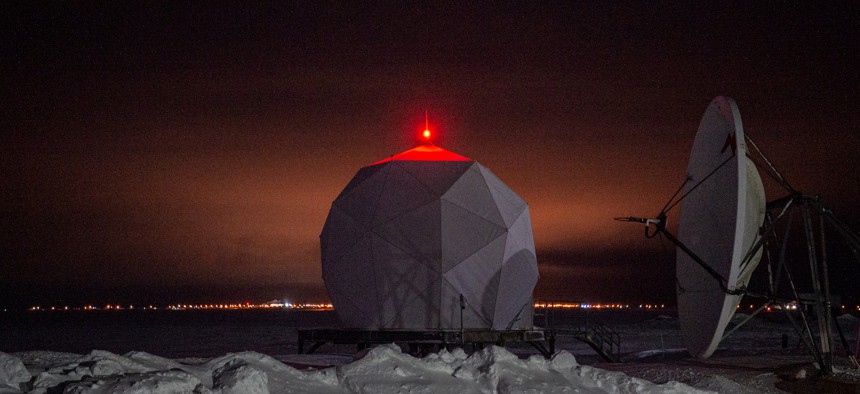Future wars will turn on space-cyber-special operations triad: Army SOF chief

The northernmost U.S. city of Utqiagvik can be seen behind Point Barrow Long Range Radar Site (LRRS) satellite at Utqiagvik, Alaska, Feb. 3, 2023. U.S. Air Force / Tech. Sgt. Curt Beach
The success of information ops is “the most important lesson learned from Ukraine right now.”
Commercial space communications, cyber effects, and influence operations are key to preventing or winning conflicts, Lt. Gen. John Braga, who leads U.S. Army Special Operations Command, said Tuesday. The United States must continue to develop each of those capabilities—and joint concepts for deploying them together—a concept modeled partially off of Ukraine, he said.
With news of high casualties emerging from areas like the Donbas, another statistic has escaped public attention, Braga said.
“Sixteen thousand Russian soldiers have deserted. Sixteen thousand have been taken off the battlefield without having to expend kinetic rounds. That's probably a combination of effects," he said during the Space Missile Defense Symposium in Huntsville, Alabama. "I would suggest that have been assisted by space capability, cyber capability, human capability, and just old-school information operations there.”
“The importance of information ops, I think, it's the most important lesson learned from Ukraine right now. And it does apply to Taiwan or the INDOPACOM scenario,” he said, referring to the effort to deter a Chinese invasion of Taiwan.
As the U.S. military has shifted away from the Middle East to counter China and Russia, U.S. special operations forces have begun to emphasize the role of rapid access to data and asymmetrical capabilities like drones and cyber effects. Braga said the war in Ukraine illustrates what those capabilities look like when they are employed as part of a coordinated effort, with each leg of the triad providing support to the overall structure. And the United States is not alone in reaching that realization.
Lt. Gen. Maria Barrett, commander of U.S. Army Cyber Command, pointed out that effective influence campaigning requires assured access to networks and, therefore, potentially denying the adversary the opportunity to use their own networks, their own systems of information dispersion. “If you're out there navigating in gray space, looking at adversary networks, and you're also over here looking at how a competitor may be delivering its influence messages, at some level, you get to a cyber layer. And so that's where the synergy comes in between Information Operations and cyber. If you want to have an effect, you can have an effect by delivering the right awesome content to counter a message where you can actually understand the infrastructure in which it's being delivered.”
This is important because our familiarity with cyberwarfare as a public is much less evolved than that of many other nations, like Estonia. But consider how an adversary might view that same opportunity set. We experience hacking and leaking campaigns such as the 2016 Russian active measures effort as events that affect other people involved in politics. We don’t consider how an adversary might scale that experience to affect us, individually. Cyberwarfare in the future could mean limited access to information spaces we take for granted.
Said Braga, “Each leg of the triad, we're seeing our adversaries being very aggressive, obviously in gray zone actor activities, irregular warfare, certainly in the space domain and certainly in the cyber domain for a long time. And as that price point and entry point lowers, and continues to lower [for deploying cyber effects, information warfare, etc.], it's going to be even more important that we don't have three disparate efforts, but one converged effort on the holistic use and synergy of the triad moving forward.”
Developing those capabilities jointly will make each one more powerful, and give policymakers better tools to decide how the United States should use them for deterrence or before a conflict starts, he said. “When you bring on a new piece of equipment, a new weapon system, a new technique, it's a question every time for policymakers, ‘Are you contributing towards escalation or towards deterrence?’ We have to be better at developing those capabilities for the policymakers and being able to deliver on those effects in order to make informed decisions [and make] a larger contribution to actual strategic deterrence there,” he said.
Combining multiple intelligence threads and capabilities together will also be key to U.S. efforts to defeat enemy swarming drones, Maj. Gen. Sean Gainey, director of the Joint Counter-small Unmanned Aircraft Systems Office, also said on Tuesday. That means combining things like high-power microwaves with smaller drones, or even ballistic interceptors, and doing so in a way that avoids firing expensive and dangerous missiles at small drones.
Ukraine, again, provides a clear example of the sort of drone problem that the United States could face. “We heard that Ukraine was going through about 10,000 UAS encounters in a month. How does the U.S. Army counter these kinds of numbers if we're going to be in an active conflict?” Gainey said.






